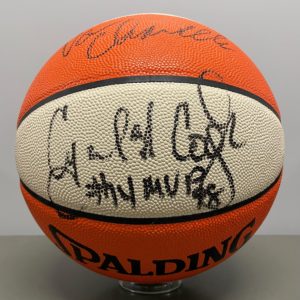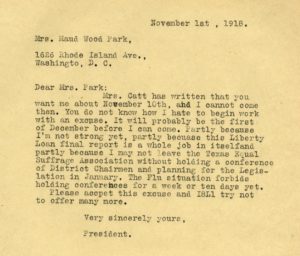
By James Burke, Intern at UH Special Collections and PhD student majoring in US History and minoring in Public History. His work involves museum archives, artifact cataloging, and exhibit curation.
The Houston Comets were among the first eight teams of the Women’s National Basketball Association (WNBA) in 1997. In their first season the Comets saw unprecedented success, playing against and beating the New York Liberty in the Championship. The Houston Comets went on to win the 1998 WNBA Championship against the Phoenix Mercury, again in 1999 against the New York Liberty, and in 2000 against the same. Throughout each of the first four seasons, the Houston Comets dominated the court. The “Big Three” Cynthia Cooper, Sheryl Swoopes, and Tina Thompson topped all statistical charts for the WNBA and were instrumental in leading the Comets to four consecutive WNBA Championship wins. While the Houston Comets were a breakout dynasty in the WNBA, after the 2008 season the team was disbanded due to ownership issues.
For the creation of this exhibit, I have had to make up for my own shortcomings in knowledge on the Houston Comets. Prior to beginning the Houston Comets exhibit, Vince Lee, Archivist for the Carey Shuart Women’s Research Collection, and I planned on working on a separate exhibit from Special Collections. However, upon getting the commission for the Comets exhibit, the two of us began working on the task immediately. While I knew people who were fans of the Houston Comets when they were active, I was ignorant to their history at the onset of the project. Working with Vince and by his advice, the first two weeks were largely spent on researching the story of the team. Furthermore, he suggested I familiarize myself with the Houston Comets Memorabilia Collection. While I have experience doing curatorial work, never had it been on something I had minimal working knowledge on, but it was, and remains, an exciting opportunity to learn.
I chose the items for the Houston Comets exhibit largely centered on the first four seasons of the team, in addition to the “Big Three”. I wanted the exhibit cases to demonstrate the history of the team and their success, but also the fans and their dedication. Across the exhibit I selected five items signed by members of the Houston Comets. In addition to signed memorabilia, I wanted to feature several Houston Comets publications throughout the exhibit, both to show the teams history as told by the WNBA, and by journalists from the Houston Chronicle. The Comets dominated the first four seasons of the WNBA, and written material reflects that. Beyond such items, I wanted to include various merchandise to show that fans of the Houston Comets remained so outside the arena.
Despite the Houston Comets only lasting for twelve seasons from 1997 to 2008, the team established a dynasty in the WNBA and made a lasting impact on both Houston and the league at-large. Fans of the Comets remained loyal during and after their time on the court, and the collection of memorabilia establishes that. While the team is no longer active, their legacy continues to permeate the WNBA and their fans to this day.
________
Explore history at UH Special Collections! We are located in M.D. Anderson Library, 2nd Floor, at the top of the stairs next to the elevators. Our reading room is open Monday-Friday, 10:00 AM-4:00 PM, excluding holidays. Appointments are strongly recommended so that requested materials can be ready for you upon your arrival. Drop-in visits are welcomed if there is available space in the reading room.
As we unveil our new digital exhibit, 100 Years of Progress: The Fight Marches On, celebrating the centennial of the passage and ratification of the 19th amendment in these times of COVID-19 and amidst a national call for social justice and equality all across the nation, let’s not forget that the women that brought about much needed change for the right to vote, faced equally great challenges during their own time. For historical context, they were dealing with the aftermath of World War I in which the world was weary of a prolonged conflict as well as the global spread of the 1918 influenza pandemic which would kill an estimated 50 million people all around the world. Texas Suffragist, Minnie Fisher Cunningham, was afflicted from the “Spanish Flu” and would recover as documented in a letter she wrote as President of the Texas Equal Suffrage Association to Mrs. Maud Wood Park in November of 1918.
If we learn anything from history and the work from Suffragettes all across the nation, it is that with grit, determination, and their eyes on the end goal of having the 19th Amendment ratified by Congress, neither a global pandemic nor a World War would derail their efforts. Through their grassroots activism in their communities, to lobbying local, state, and national representatives, to bending the ear of a US President, they would not be denied in their efforts as they would find a way. They would become united in voice and action as an immovable force in which once their momentum has started, nothing would be able to stop nor stand in their way.
The creation of this exhibit has been a unique experience to say the least. Working with public history student, Jennifer Southerland, since this past fall and early spring, we had mapped out and selected many of the materials. Then the COVID-19 pandemic hit in late March, putting a stop to our physical process and planning as we could no longer go into the office. Rather than stop all the work and planning that had gone before, Jennifer and I continued to meet weekly via phone, and working collaboratively with online tools such as Zoom, Google Docs, and Google Sheets to arrange the digital materials (including the Minnie Fisher Cunningham Papers and Mary Ellen Ewing vs the Houston School Board) that were available, requesting scans of other materials that had not been digitized, drafting descriptive text for the materials, and brainstorming on potential themes that would emerge from the exhibit.
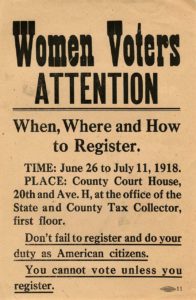
“Women Voters Attention – When, Where and How to Register,” 1918 flier distributed to inform women on how to register to vote, featured in the current exhibition
With so many face to face gatherings, events, and programs being cancelled due to COVID-19 the thought process in the creation of this digital exhibit has focused on how we could organize the digital materials we already have into a virtual exhibit which is openly accessible to the public whether it be in their homes or home offices. Just as the early suffragists found a way to overcome despite all the odds, we wanted to use the technology at our disposal to still make this happen despite the challenges posed by COVID-19 and social distancing.
In a more normal setting a physical exhibit would be created first with physical materials selected, matted, backed, and captions created before they are arranged and installed into exhibit cases within the library. We’ve had to take the opposite approach of working backwards, creating a digital exhibit first, which we know will be remotely available to the public, and then later this fall install the physical materials into the cases based on the digital exhibit. What we’ve learned is that although the pandemic has changed the logistics and dynamics of how an exhibit may ultimately be put together, we’ve still found a way to virtually document and celebrate the work of Suffragists all across the nation. This exhibit is dedicated in honor of their grit, determination, and spirit of fighting on.
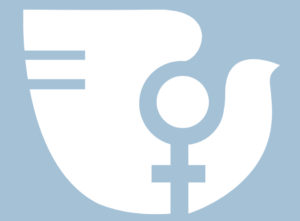 A challenge from Gloria Steinem was issued to women to come forth and have their stories from the 1977 National Women’s Conference told. During the 2017 Reunion conference held at the University of Houston to mark the 40th Anniversary of the 1977 National Women’s Conference, over thirty women stepped forward to participate in having their stories of this historic occasion recorded for posterity. The recorded interviews capture stories from delegate attendees, many of which haven’t been heard for over 40 years. Women too young or unable to have attended the original conference also contributed their own personal stories, views, and insights into what the 1977 National Women’s Conference has meant to them and how the effects from the conference still resonate in their personal lives.
A challenge from Gloria Steinem was issued to women to come forth and have their stories from the 1977 National Women’s Conference told. During the 2017 Reunion conference held at the University of Houston to mark the 40th Anniversary of the 1977 National Women’s Conference, over thirty women stepped forward to participate in having their stories of this historic occasion recorded for posterity. The recorded interviews capture stories from delegate attendees, many of which haven’t been heard for over 40 years. Women too young or unable to have attended the original conference also contributed their own personal stories, views, and insights into what the 1977 National Women’s Conference has meant to them and how the effects from the conference still resonate in their personal lives.
Among some of the stories shared from the conference were from Peggy Kokernot Kaplan, one of the original torch relay runners during the 1977 Conference, Frances Henry, coordinator for state meetings leading up the National Women’s Conference, and University of Houston Law Professor Laura Oren, an attendee of the conference and early member of the Houston Area Feminist Federal Credit Union.
The Share your Stories campaign was recorded over two days, November 6-7, 2017 as part of the 40th Anniversary conference held at the University of Houston. The Share your Stories interviews can be found on the Audio/Visual Repository of the University of Houston Libraries. Additional information and materials on the 1977 National Women’s Conference can be found in the Marjorie Randal National Women’s Conference Collection of the Carey C. Shuart Women’s Archive and Research Collection.
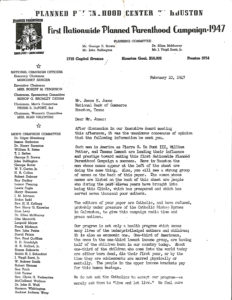
“The editors of your paper are Catholic, and have refused… to give this campaign radio time and press notices… We do not ask the Catholics to accept our program–we merely ask them to ‘live and let live.'” Letter from Agnese Carter Nelms to Jesse H. Jones, February 10, 1947, Planned Parenthood of Houston and Southeast Texas Records.
A new collaboration between the University of Houston Special Collections, the Department of History, and the Women’s, Gender & Sexuality Studies provided students with a unique opportunity to discover archival collections neatly aligned with their own areas of research interest.
Students from Dr. Zarnow’s Issues in Feminist Research class worked with librarians from our Special Collections to mine a variety of archival artifacts in collections from Carey C. Shuart Women’s Research Collection, the LGBT History Research Collection, and the Arté Publico Press Recovery Project to create an interactive timeline of primary sources discovered in their research. From materials tucked into archival folders, possibly overlooked by previous researchers, students uncovered items revealing the evolution of women’s social issues and concerns in the Houston and Gulf Coast region and the themes that connect these years of seemingly disparate work from a chain of individuals and organizations over decades.
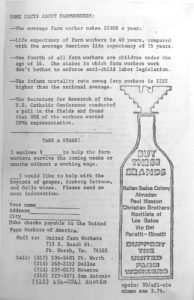
Boycott Gallo flyer, Houston Area NOW and Other Feminist Activities Collection.
Among the items highlighted from their research are correspondence from the 1940s, political flyers from the 1970s, and artists’ creations from the 1980s. In the Planned Parenthood of Houston & Southeast Texas Records, a 1947 letter from Agnese Carter Nelms to Jesse H. Jones, owner of the Houston Chronicle among other things, hints at the early conflicts between Planned Parenthood and the Catholic Church. A flier from the Houston Area NOW and Other Feminist Activities Collection recalls the gains won by César Chávez and the United Farm Workers but reminds us that, even now, there’s still blood in that wine. Meanwhile, photographs, posters, and other works of art from the Houston Gorilla Girls Records demonstrate how activism for gender equality in the world of art played out against the backdrop of 1980s Houston. Students worked to curate and describe these items and more, creating an interactive timeline (seen above) to provide users with visual and historical context while browsing their findings.
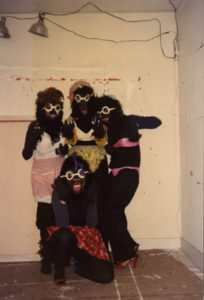
Photograph from the Houston Gorilla Girls Records.
If you are a faculty member, or student, interested in how the primary source materials housed in UH Special Collections can complement your teaching, learning, and research, see our website with more information on scheduling classes and utilizing our resources to learn more.
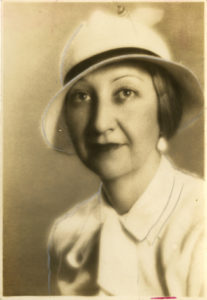
undated portrait of Joyce Burg, from the Betty Trapp Chapman Papers
The University of Houston Special Collections is proud to announce the publication of a new finding aid for the Betty Trapp Chapman Papers. Emily Brooks, Graduate Assistant for the Carey Shuart Women’s Archive, has recently completed the processing of the papers, penned the new finding aid, and was generous enough to share some of her thoughts on the new collection.
In 2004, Ellen Elkins Grimes, Chair of the Women in the Profession Committee of the State Bar of Texas was asked to give a speech about the history of female lawyers who paved the way for today’s women in law. She quickly realized that there was very little information available, especially regarding the early female pioneers of the law in Texas. She decided that the State Bar association should sponsor a book on the history of Texas female lawyers and appointed Betty Trapp Chapman, a prominent Houston historian to complete the research and writing of what would become Rough Road to Justice: The Journey of Women Lawyers in Texas (2008). Chapman is the author of several books on Houston and Texas history such as Historic Houston (2011) and Houston Women: Invisible Threads in the Tapestry (2000).
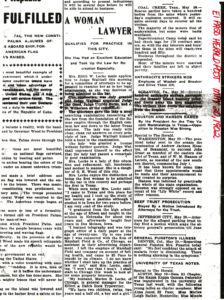
“A Woman Lawyer” (El Paso Herald Post, May 20, 1902, Betty Trapp Chapman Papers)
From Edith Locke, the first woman licensed to practice in El Paso in 1902, to nationally prominent Texas women like Sandra Day O’ Connor, Kay Bailey Hutchinson, and Sheila Jackson Lee, Rough Road to Justice tracks the journey of these women as they overcame discrimination and harassment to succeed in the legal profession. Chapman explores broad social issues that impacted women in the legal profession as well as individual trailblazers that made it possible for women to pursue careers in law today. One such woman was Joyce M. Burg, the first woman to practice law in Houston after she graduated from the University of Texas Law School in 1926 – one of only four women in her class. She went on to become the “grand dame of Houston’s family law system,” practiced law for 60 years and founded the Harris County Women Attorneys Association. When she passed away in 1997 at the age of 96, she was the oldest member of the Houston Bar Association.
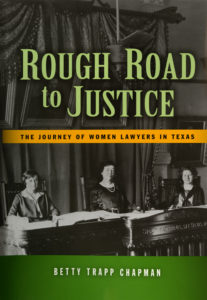
cover of Rough Road to Justice: The Journey of Women Lawyers in Texas (2008)
This collection enriches the Carey C. Shuart Women’s Archive and Research Collection with the often-untold stories of Texas women in the law, unique correspondence with these women and their descendants, as well as original photographs of several of the women featured in Rough Road to Justice. For more information, we invite you to visit our reading room where the Betty Trapp Chapman Papers can be explored.
